Monitoring and Simulation of 3-Meter Soil Water Profile Dynamics in a Pine Forest
Abstract
:1. Introduction
2. Materials and Methods
2.1. Description of the Study Site
2.2. Hydrometeorological Data Monitoring and Calculation
2.3. Hydrus-1D Simulates Unsaturated Soil Water
2.4. Model Parameter Calibration
2.5. Statistical Methods
2.5.1. Root Mean Square Error (RMSE)
2.5.2. Explanatory Coefficients ()
3. Results
3.1. Soil Water Dynamics at Different Depths
3.2. Model Simulation Results
4. Discussion
4.1. Vertical Variation Characteristics and Driving Forces of Soil Water Content
4.2. Soil Water Simulations Require More Detailed Consideration
5. Conclusions
Author Contributions
Funding
Data Availability Statement
Conflicts of Interest
References
- Lyu, S.; Wang, J. Soil Water Stable Isotopes Reveal Surface Soil Evaporation Loss Dynamics in a Subtropical Forest Plantation. Forests 2021, 12, 1648. [Google Scholar] [CrossRef]
- Evaristo, J.; Kim, M.; van Haren, J.; Pangle, L.A.; Harman, C.J.; Troch, P.A.; McDonnell, J.J. Characterizing the Fluxes and Age Distribution of Soil Water, Plant Water, and Deep Percolation in a Model Tropical Ecosystem. Water Resour. Res. 2019, 55, 3307–3327. [Google Scholar] [CrossRef]
- Broedel, E.; Tomasella, J.; Cândido, L.A.; von Randow, C. Deep Soil Water Dynamics in an Undisturbed Primary Forest in Central Amazonia: Differences between Normal Years and the 2005 Drought. Hydrol. Process. 2017, 31, 1749–1759. [Google Scholar] [CrossRef]
- Yang, F.; Feng, Z.; Wang, H.; Dai, X.; Fu, X. Deep Soil Water Extraction Helps to Drought Avoidance but Shallow Soil Water Uptake during Dry Season Controls the Inter-Annual Variation in Tree Growth in Four Subtropical Plantations. Agric. For. Meteorol. 2017, 234, 106–114. [Google Scholar] [CrossRef]
- Zunzunegui, M.; Boutaleb, S.; Díaz Barradas, M.C.; Esquivias, M.P.; Valera, J.; Jáuregui, J.; Tagma, T.; Ain-Lhout, F. Reliance on Deep Soil Water in the Tree Species Argania Spinosa. Tree Physiol. 2017, 38, 678–689. [Google Scholar] [CrossRef] [PubMed]
- Klein, T.; Rotenberg, E.; Cohen-Hilaleh, E.; Raz-Yaseef, N.; Tatarinov, F.; Preisler, Y.; Ogée, J.; Cohen, S.; Yakir, D. Quantifying Transpirable Soil Water and Its Relations to Tree Water Use Dynamics in a Water-Limited Pine Forest. Ecohydrology 2014, 7, 409–419. [Google Scholar] [CrossRef]
- Spanner, G.C.; Gimenez, B.O.; Wright, C.L.; Menezes, V.S.; Newman, B.D.; Collins, A.D.; Jardine, K.J.; Negrón-Juárez, R.I.; Lima, A.J.N.; Rodrigues, J.R.; et al. Dry Season Transpiration and Soil Water Dynamics in the Central Amazon. Front. Plant Sci. 2022, 13. [Google Scholar] [CrossRef]
- Stahl, C.; Hérault, B.; Rossi, V.; Burban, B.; Bréchet, C.; Bonal, D. Depth of Soil Water Uptake by Tropical Rainforest Trees during Dry Periods: Does Tree Dimension Matter? Oecologia 2013, 173, 1191–1201. [Google Scholar] [CrossRef]
- Hasselquist, N.J.; Benegas, L.; Roupsard, O.; Malmer, A.; Ilstedt, U. Canopy Cover Effects on Local Soil Water Dynamics in a Tropical Agroforestry System: Evaporation Drives Soil Water Isotopic Enrichment. Hydrol. Process. 2018, 32, 994–1004. [Google Scholar] [CrossRef]
- Acharya, B.S.; Dodla, S.; Wang, J.J.; Pavuluri, K.; Darapuneni, M.; Dattamudi, S.; Maharjan, B.; Kharel, G. Biochar Impacts on Soil Water Dynamics: Knowns, Unknowns, and Research Directions. Biochar 2024, 6, 34. [Google Scholar] [CrossRef]
- Jiang, Z.-Y.; Wang, X.-D.; Zhang, S.-Y.; He, B.; Zhao, X.-L.; Kong, F.-L.; Feng, D.; Zeng, Y.-C. Response of Soil Water Dynamics to Rainfall on A Collapsing Gully Slope: Based on Continuous Multi-Depth Measurements. Water 2020, 12, 2272. [Google Scholar] [CrossRef]
- Njana, M.A.; Mbilinyi, B.; Eliakimu, Z. The Role of Forests in the Mitigation of Global Climate Change: Emprical Evidence from Tanzania. Environ. Chall. 2021, 4, 100170. [Google Scholar] [CrossRef]
- Wang, Y.; He, Y.; Li, Z.; Qu, J.; Wang, G. Soil Water Dynamics and Deep Percolation in an Agricultural Experimental Area of the North China Plain over the Past 50 Years: Based on Field Monitoring and Numerical Modeling. Sci. Total Environ. 2024, 928, 172367. [Google Scholar] [CrossRef] [PubMed]
- Srivastava, P.K. Satellite Soil Moisture: Review of Theory and Applications in Water Resources. Water Resour. Manag. 2017, 31, 3161–3176. [Google Scholar] [CrossRef]
- Chen, T.; McVicar, T.R.; Wang, G.; Chen, X.; De Jeu, R.A.M.; Liu, Y.Y.; Shen, H.; Zhang, F.; Dolman, A.J. Advantages of Using Microwave Satellite Soil Moisture over Gridded Precipitation Products and Land Surface Model Output in Assessing Regional Vegetation Water Availability and Growth Dynamics for a Lateral Inflow Receiving Landscape. Remote Sens. 2016, 8, 428. [Google Scholar] [CrossRef]
- Saxton, K.E.; Rawls, W.J. Soil Water Characteristic Estimates by Texture and Organic Matter for Hydrologic Solutions. Soil Sci. Soc. Am. J. 2006, 70, 1569–1578. [Google Scholar] [CrossRef]
- An, N.; Tang, C.-S.; Cheng, Q.; Wang, D.-Y.; Shi, B. Laboratory Characterization of Sandy Soil Water Content during Drying Process Using Electrical Resistivity/Resistance Method (ERM). Bull. Eng. Geol. Environ. 2020, 79, 4411–4427. [Google Scholar] [CrossRef]
- Jeřábek, J.; Zumr, D.; Dostál, T. Identifying the Plough Pan Position on Cultivated Soils by Measurements of Electrical Resistivity and Penetration Resistance. Soil Tillage Res. 2017, 174, 231–240. [Google Scholar] [CrossRef]
- Tamboli, P.M. The Influence of Bulk Density and Aggregate Size on Soil Moisture Retention. Ph.D. Thesis, Iowa State University of Science and Technology, Iowa, IA, USA, 1961. [Google Scholar]
- Balaghi, S.; Ghal–Eh, N.; Mohammadi, A.; Vega–Carrillo, H.R. A Neutron Scattering Soil Moisture Measurement System with a Linear Response. Appl. Radiat. Isot. 2018, 142, 167–172. [Google Scholar] [CrossRef]
- Gardner, W.R.; Kirkham, D.J. Determination of Soil Moisture by Neutron Scattering. Soil Sci. 1952, 73, 391–402. [Google Scholar] [CrossRef]
- Zawilski, B.M.; Granouillac, F.; Claverie, N.; Lemaire, B.; Brut, A.; Tallec, T. Calculation of Soil Water Content Using Dielectric-Permittivity-Based Sensors—Benefits of Soil-Specific Calibration. Geosci. Instrum. Methods Data Syst. 2023, 12, 45–56. [Google Scholar] [CrossRef]
- Robinson, D.A.; Campbell, C.S.; Hopmans, J.W.; Hornbuckle, B.K.; Jones, S.B.; Knight, R.; Ogden, F.; Selker, J.; Wendroth, O. Soil Moisture Measurement for Ecological and Hydrological Watershed-Scale Observatories: A Review. Vadose Zone J. 2008, 7, 358–389. [Google Scholar] [CrossRef]
- Fan, J.; Scheuermann, A.; Guyot, A.; Baumgartl, T.; Lockington, D.A. Quantifying Spatiotemporal Dynamics of Root-Zone Soil Water in a Mixed Forest on Subtropical Coastal Sand Dune Using Surface ERT and Spatial TDR. J. Hydrol. 2015, 523, 475–488. [Google Scholar] [CrossRef]
- Sposito, G. The Statistical Mechanical Theory of Water Transport through Unsaturated Soil: 2. Derivation of the Buckingham-Darcy Flux Law. Water Resour. Res. 1978, 14, 479–484. [Google Scholar] [CrossRef]
- Sławiński, C.; Sobczuk, H. Soil–Plant–Atmosphere Continuum. In Encyclopedia of Agrophysics; Gliński, J., Horabik, J., Lipiec, J., Eds.; Springer: Dordrecht, The Nederlands, 2011; pp. 805–810. [Google Scholar] [CrossRef]
- Werner, C.; Dubbert, M. Resolving Rapid Dynamics of Soil–Plant–Atmosphere Interactions. New Phytol. 2016, 210, 767–769. [Google Scholar] [CrossRef]
- Orlowski, N.; Rinderer, M.; Dubbert, M.; Ceperley, N.; Hrachowitz, M.; Gessler, A.; Rothfuss, Y.; Sprenger, M.; Heidbüchel, I.; Kübert, A.; et al. Challenges in Studying Water Fluxes within the Soil-Plant-Atmosphere Continuum: A Tracer-Based Perspective on Pathways to Progress. Sci. Total Environ. 2023, 881, 163510. [Google Scholar] [CrossRef]
- Chali, A.K.N.; Hashemi, S.R.; Akbarpour, A. Numerical Solution of the Richards Equation in Unsaturated Soil Using the Meshless Petrov–Galerkin Method. Appl. Water Sci. 2023, 13, 119. [Google Scholar] [CrossRef]
- Vereecken, H.; Schnepf, A.; Hopmans, J.W.; Javaux, M.; Or, D.; Roose, T.; Vanderborght, J.; Young, M.H.; Amelung, W.; Aitkenhead, M.; et al. Modeling Soil Processes: Review, Key Challenges, and New Perspectives. Vadose Zone J. 2016, 15, vzj2015-09. [Google Scholar] [CrossRef]
- Sadeghi, M.; Hatch, T.; Huang, G.; Bandara, U.; Ghorbani, A.; Dogrul, E.C. Estimating Soil Water Flux from Single-Depth Soil Moisture Data. J. Hydrol. 2022, 610, 127999. [Google Scholar] [CrossRef]
- Rai, V.; Pramanik, P.; Das, T.K.; Aggarwal, P.; Bhattacharyya, R.; Krishnan, P.; Sehgal, V.K. Modelling Soil Hydrothermal Regimes in Pigeon Pea under Conservation Agriculture Using Hydrus-2D. Soil Tillage Res. 2019, 190, 92–108. [Google Scholar] [CrossRef]
- Gabiri, G.; Burghof, S.; Diekkrüger, B.; Leemhuis, C.; Steinbach, S.; Näschen, K. Modeling Spatial Soil Water Dynamics in a Tropical Floodplain, East Africa. Water 2018, 10, 191. [Google Scholar] [CrossRef]
- Mo’allim, A.A.; Kamal, M.R.; Muhammed, H.H.; Yahaya, N.K.E.M.; Zawawe, M.A.B.M.; Man, H.B.C.; Wayayok, A. An Assessment of the Vertical Movement of Water in a Flooded Paddy Rice Field Experiment Using Hydrus-1D. Water 2018, 10, 783. [Google Scholar] [CrossRef]
- Allen, R.G.; Pereira, L.S.; Raes, D.; Smith, M. Crop Evapotranspiration: Guidelines for Computing Crop Water Requirements. Fao Rome 1998, 300, D05109. [Google Scholar]
- Richards, L.A. Capillary Conduction of Liquids Through Porous Mediums. Physics 1931, 1, 318–333. [Google Scholar] [CrossRef]
- Feddes, R.A.; Kowalik, P.J.; Zaradny, H. Simulation of Field Water Use and Crop Yield; John Wiley & Sons Inc.: Hoboken, NJ, USA, 1978. [Google Scholar]
- Rabbel, I.; Bogena, H.; Neuwirth, B.; Diekkrüger, B. Using Sap Flow Data to Parameterize the Feddes Water Stress Model for Norway Spruce. Water 2018, 10, 279. [Google Scholar] [CrossRef]
- Wang, Y.; Ma, R.; Zhu, G. Representation of the Influence of Soil Structure on Hydraulic Conductivity Prediction. J. Hydrol. 2023, 619, 129330. [Google Scholar] [CrossRef]
- Altinalmazis-Kondylis, A.; Muessig, K.; Meredieu, C.; Jactel, H.; Augusto, L.; Fanin, N.; Bakker, M.R. Effect of Tree Mixtures and Water Availability on Belowground Complementarity of Fine Roots of Birch and Pine Planted on Sandy Podzol. Plant Soil 2020, 457, 437–455. [Google Scholar] [CrossRef]
- Knipfer, T. Future in the Past: Water Uptake Function of Root Systems. Plant Soil 2022, 481, 495–500. [Google Scholar] [CrossRef]
- Kim, N.W.; Chung, I.M.; Won, Y.S.; Arnold, J.G. Development and Application of the Integrated SWAT–MODFLOW Model. J. Hydrol. 2008, 356, 1–16. [Google Scholar] [CrossRef]
- Sheikha-BagemGhaleh, S.; Babazadeh, H.; Rezaie, H.; Sarai-Tabrizi, M. The Effect of Climate Change on Surface and Groundwater Resources Using WEAP-MODFLOW Models. Appl. Water Sci. 2023, 13, 121. [Google Scholar] [CrossRef]



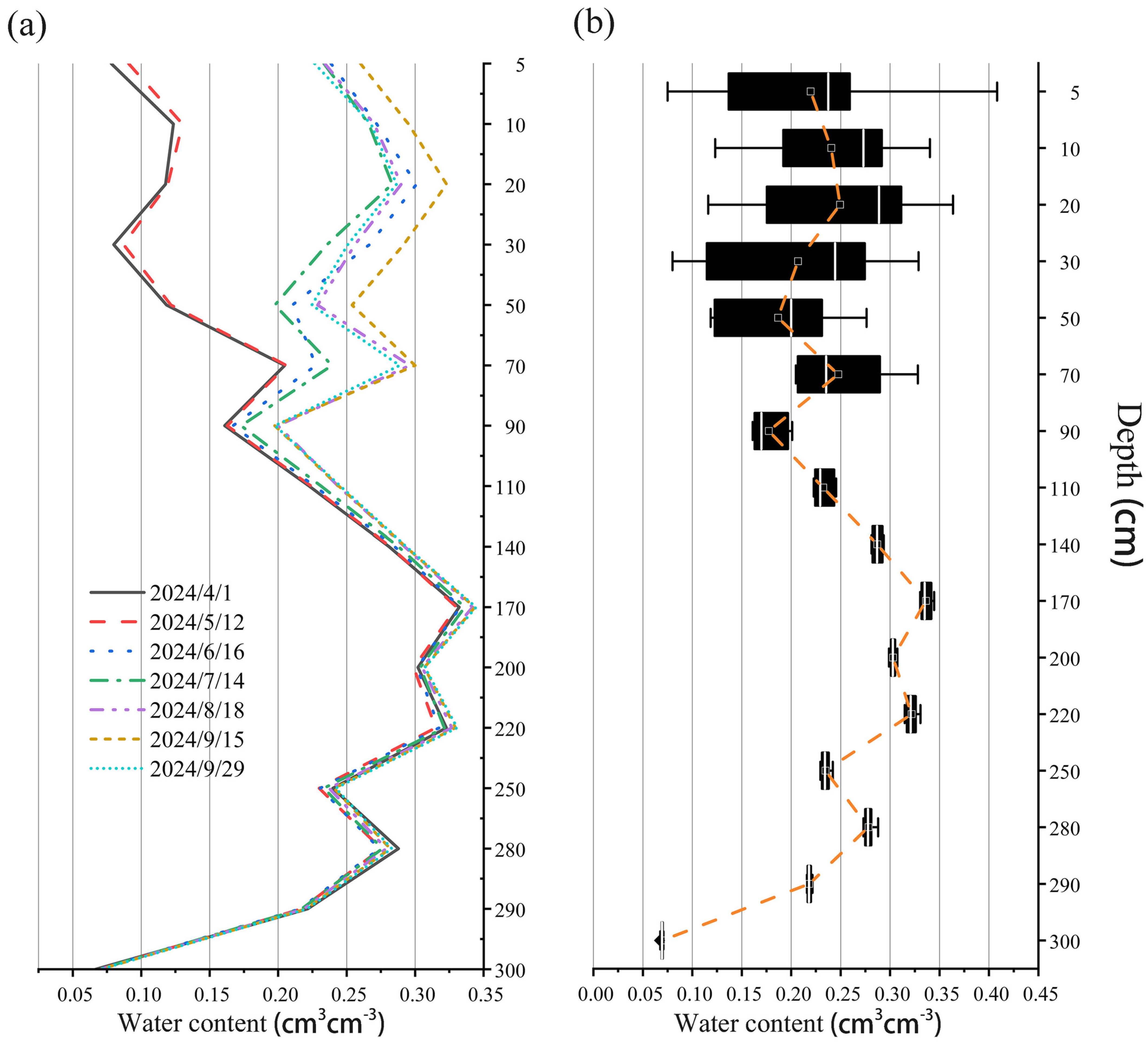
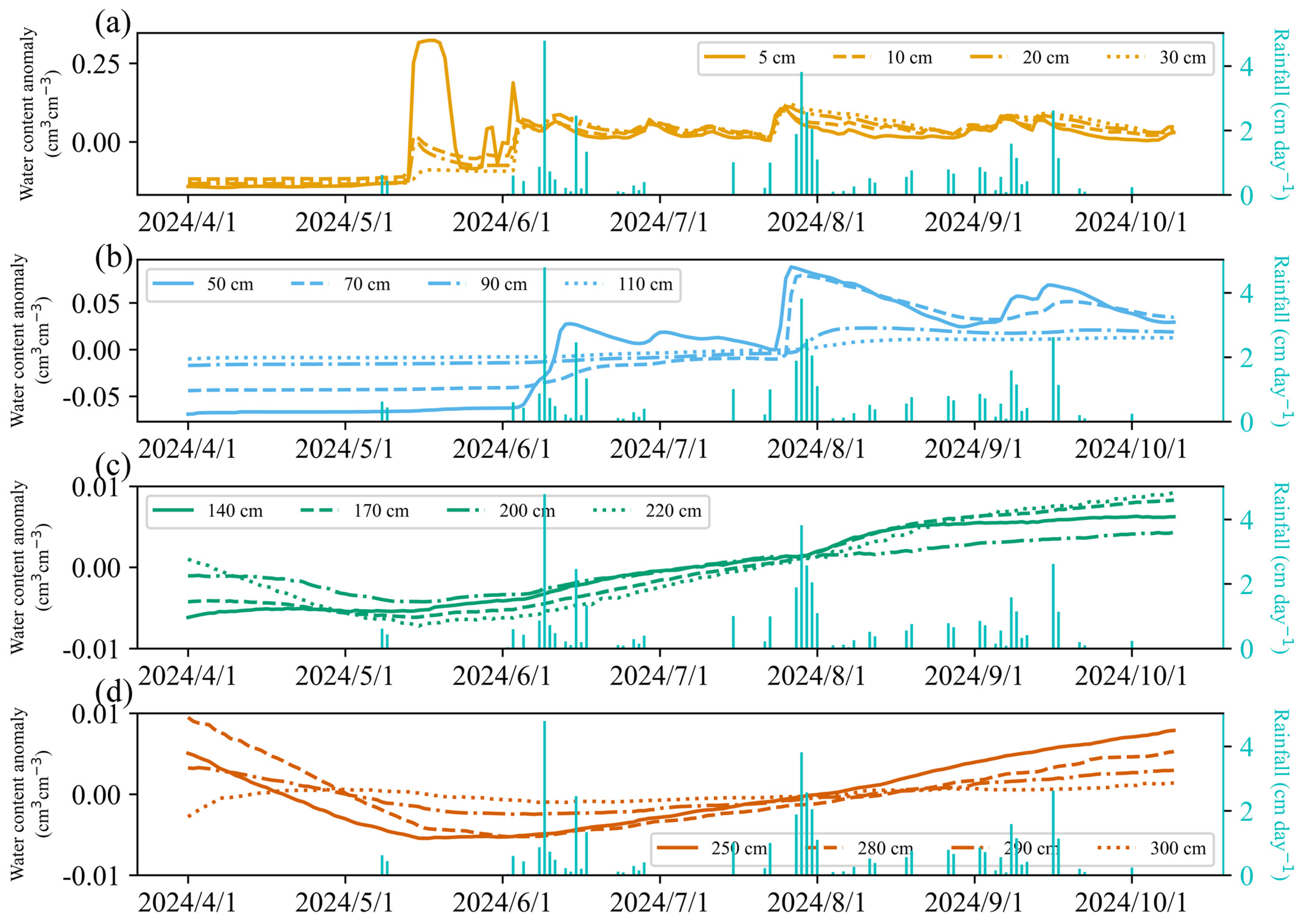

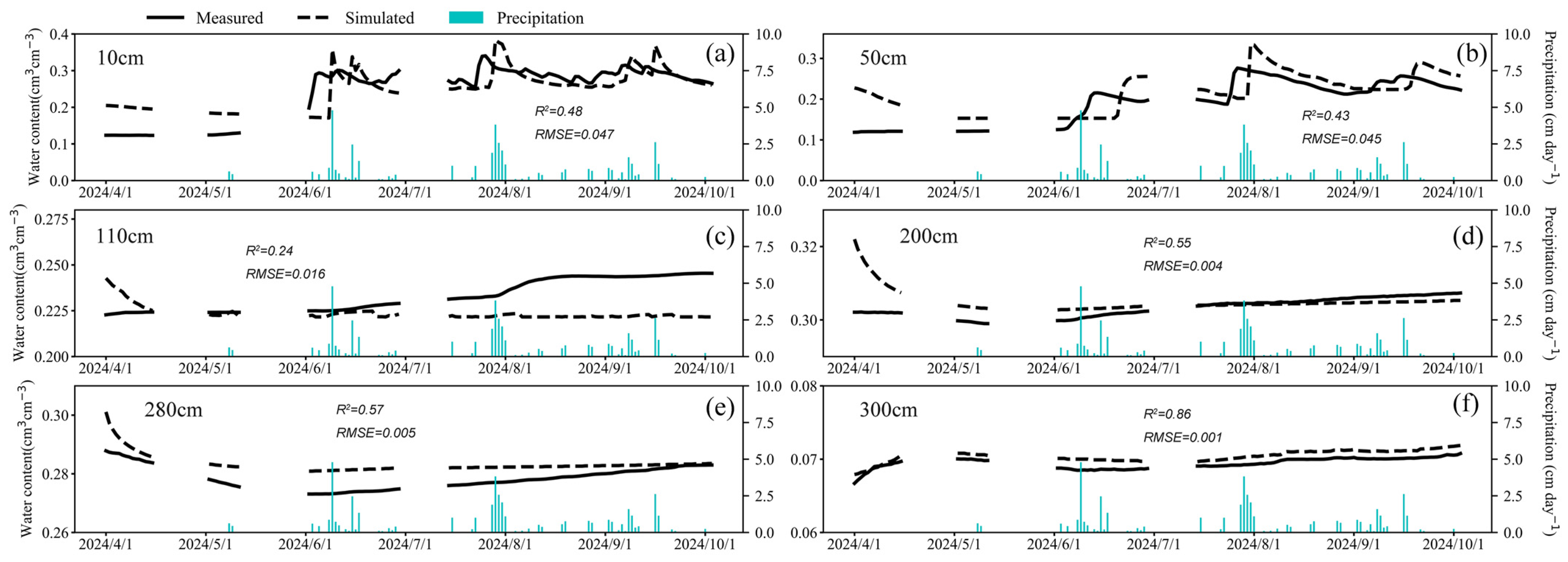
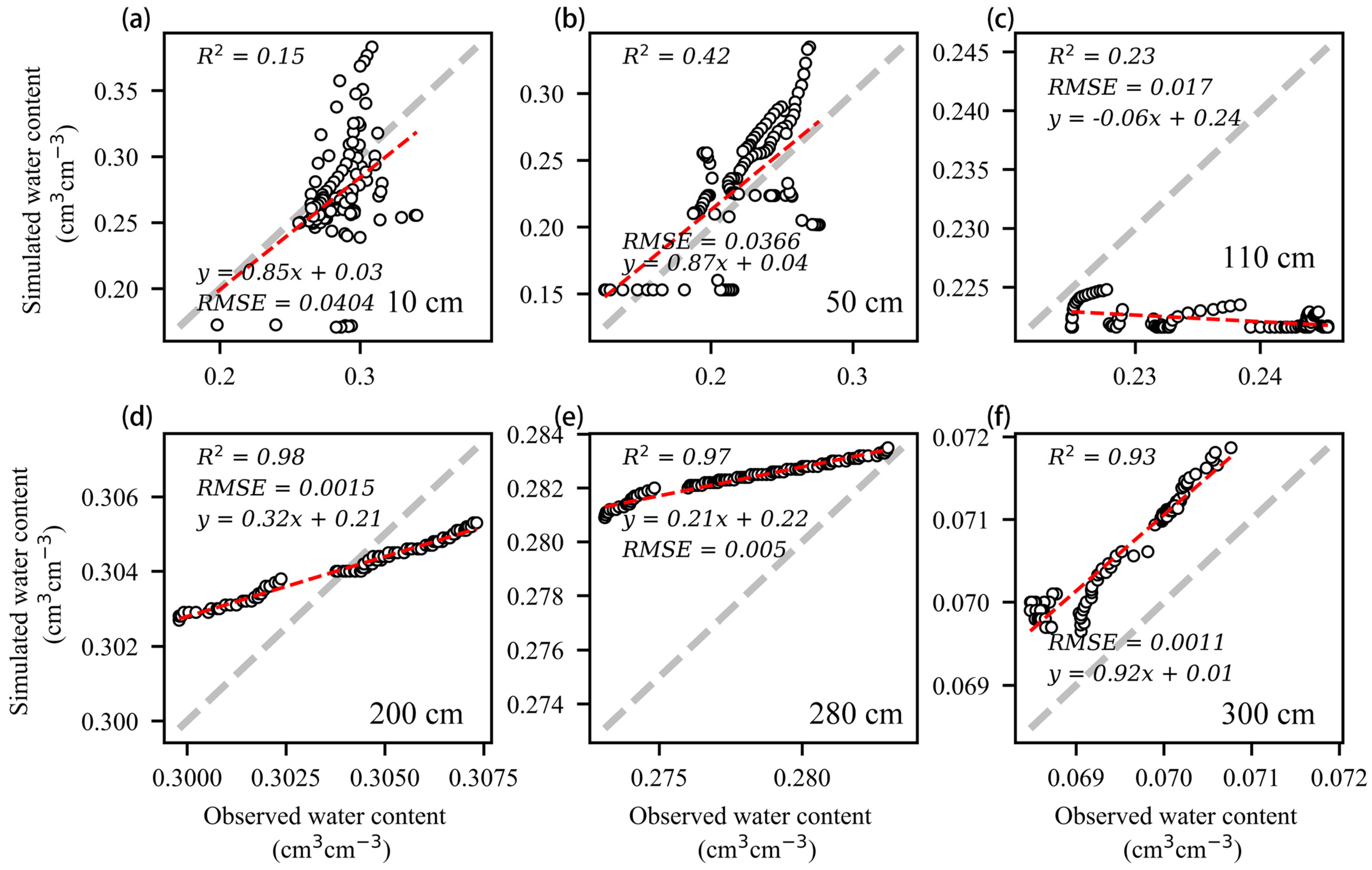

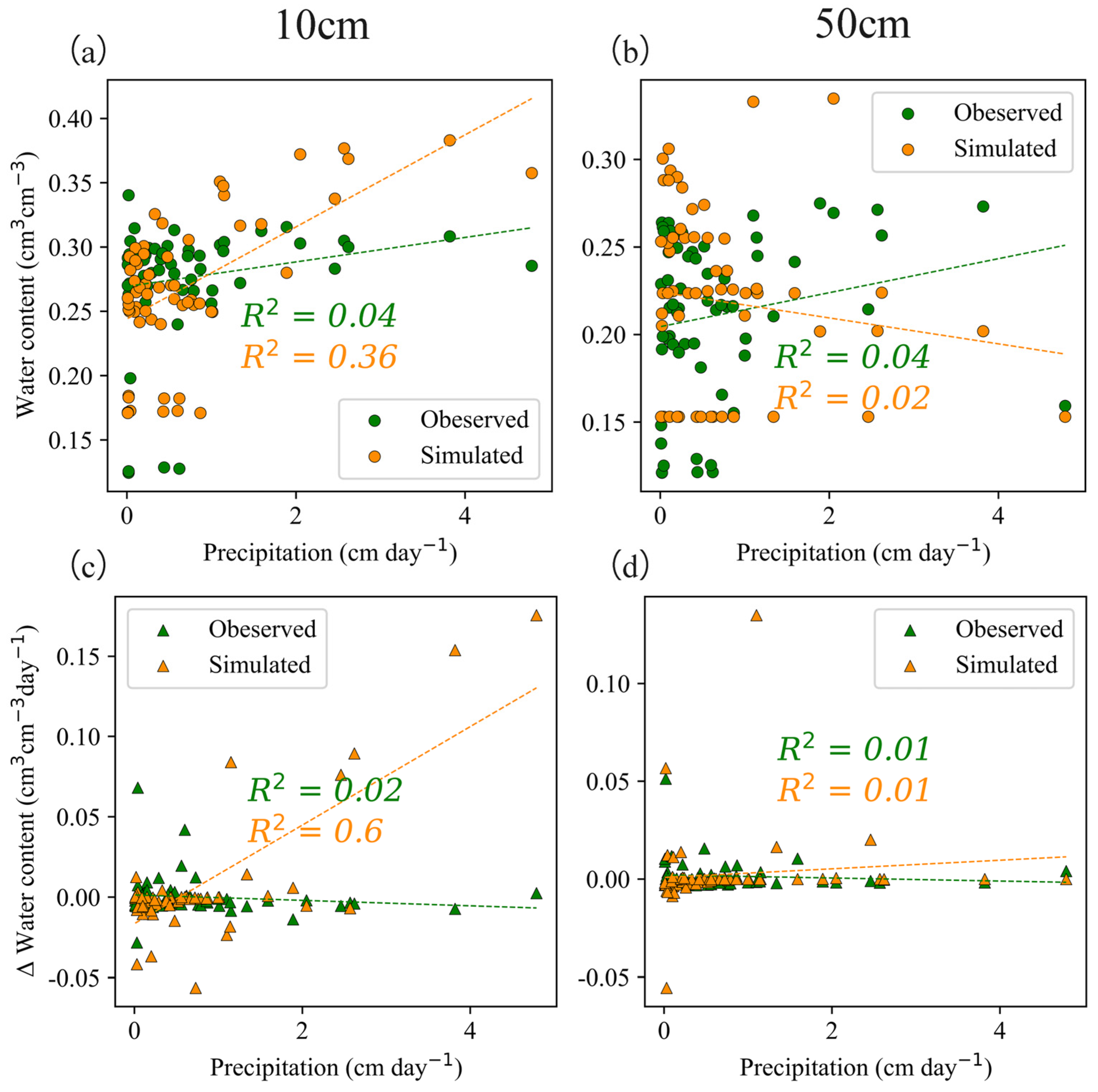
| p0 (cm) | P0pt (cm) | P2H (cm) | P2L (cm) | P3 (cm) | r2H | r2L |
|---|---|---|---|---|---|---|
| 0 | 0 | 0.5 | 0.1 |
| Layers | ||||||
|---|---|---|---|---|---|---|
| 0–70 cm | 0.15 | 0.38 | 0.145 | 1.56 | 14.96 | 0.50 |
| 70–170 cm | 0.14 | 0.25 | 0.011 | 1.56 | 5.56 | 0.50 |
| 170–300 cm | 0.16 | 0.33 | 0.016 | 1.50 | 4.47 | 0.50 |
Disclaimer/Publisher’s Note: The statements, opinions and data contained in all publications are solely those of the individual author(s) and contributor(s) and not of MDPI and/or the editor(s). MDPI and/or the editor(s) disclaim responsibility for any injury to people or property resulting from any ideas, methods, instructions or products referred to in the content. |
© 2025 by the authors. Licensee MDPI, Basel, Switzerland. This article is an open access article distributed under the terms and conditions of the Creative Commons Attribution (CC BY) license (https://creativecommons.org/licenses/by/4.0/).
Share and Cite
Luo, L.-X.; Liu, Y.; Yang, X.; Jin, Y.; Liu, Y.; Li, Y.; Zhang, M.; Guo, X.-B.; Gu, Y.; Wen, Z.-Y.; et al. Monitoring and Simulation of 3-Meter Soil Water Profile Dynamics in a Pine Forest. Water 2025, 17, 1199. https://doi.org/10.3390/w17081199
Luo L-X, Liu Y, Yang X, Jin Y, Liu Y, Li Y, Zhang M, Guo X-B, Gu Y, Wen Z-Y, et al. Monitoring and Simulation of 3-Meter Soil Water Profile Dynamics in a Pine Forest. Water. 2025; 17(8):1199. https://doi.org/10.3390/w17081199
Chicago/Turabian StyleLuo, Long-Xiao, Yan Liu, Xu Yang, Yan Jin, Yue Liu, Yuan Li, Mou Zhang, Xin-Bo Guo, Yang Gu, Zhen-Yi Wen, and et al. 2025. "Monitoring and Simulation of 3-Meter Soil Water Profile Dynamics in a Pine Forest" Water 17, no. 8: 1199. https://doi.org/10.3390/w17081199
APA StyleLuo, L.-X., Liu, Y., Yang, X., Jin, Y., Liu, Y., Li, Y., Zhang, M., Guo, X.-B., Gu, Y., Wen, Z.-Y., Peng, M.-J., Sun, Z.-Y., & Tan, Z.-H. (2025). Monitoring and Simulation of 3-Meter Soil Water Profile Dynamics in a Pine Forest. Water, 17(8), 1199. https://doi.org/10.3390/w17081199








